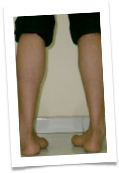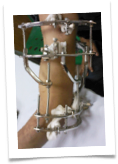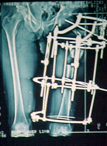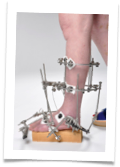




What is Limb lengthening?
Limb lengthening is a surgical technique of elongating the height of the thigh-bone (femur) or the leg-bones (tibia & fibula) to achieve an overall lengthening of the lower limb.
It is meant for patients who have limb length discrepancy (LLD) due to previous injuries or congenital anomalies, but can also be used to increase the height of otherwise normal people.
How does it work?
Lengthening happens by creating a break in the bone and gradually distracting the bone ends apart. The bone attempts to repair and heal this break by forming new bone (called callus) that is initially soft and later becomes hard and welds to the rest of the bone. During the phase when this callus is still soft, it can be distracted gradually by pulling the 2 bone-ends apart gradually. This is usually done at a rate of 1mm / day. When the desired length is achieved the bone formed in the gap (called regenerate) is left until it becomes hard.
The phase of lengthening is called “distraction phase” and the time of waiting for the bone to solidify is called “consolidation phase”.
The different methods used
External Fixation
This is the most widely used method of lengthening the leg-bones. The commonest frame used is called the “Ilizarov frame”. It involves a frame formed of metal rings that surround the leg and is fixed to the bones by fine wires. The bone is broken and the frame rings are gradually moved apart to pull the bone ends apart gradually.
Lengthening over Nail
A metal rod (nail) is inserted inside the bone together with the external fixator (usually a smaller type). The fixator is used to achieve the distraction phase and is then removed. The nail then continues to hold the bone until it becomes solid. This technique is done to decrease the External fixator time. This technique carries a higher risk of deep bone infection.
Internal Lengthening Nails
These are the most recent advances in limb lengthening. A special nail, which has a special mechanism that allows it to gradually lengthen, is implanted within the bone. This technique is not suitable to all patients.
The technique to be used to lengthen your bones is chosen individually according to each patient’s circumstances.
How much length to gain?
If there is a LLD then the aim is to equalize the short limb to the length of the longer one. In cosmetic lengthening, one could think that the best is to gain as much length as possible. However, the less lengthening required, the safer and faster is the whole procedure.
In general, up to 4 cm is safe and relatively easy to achieve. Between 4 cm and 7 cm is much harder and involves a higher risk of complications. Lengthening above 7 cm involves considerably higher risks of complications and a significantly longer time in the frame. This last level on lengthening is better to be avoided if possible.
Limb Lengthening





Mr. Hisham Shalaby

Consultant Orthopaedic Surgeon
2-8 Millar Crescent Morningside
Edinburgh
EH10 5HW
Telephone: 0131 446 3048
Fax: 0131 447 5778
